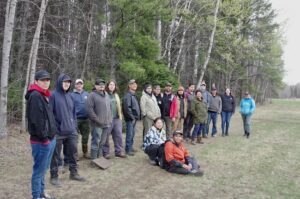Lakehead University Anthropology department performs archaeological dig in Thunder Bay

By Rick Garrick
THUNDER BAY — A recent Lakehead University Anthropology department archaeological dig has found evidence of quarrying and the use of taconite, a local stone, to make tools along the McIntyre River in Thunder Bay.
“We believe that this occurred about 4,000 years ago when the shore of Lake Superior was higher than today and covered much of the city,” says Matthew Boyd, chair of Lakehead University’s Department of Anthropology. “Stone tools were important for survival because they provided people with equipment to hunt, prepare hide clothing and shelter, and other necessities.”
Boyd says every archaeological site has a story, which takes a lot of patience and time to get out.
“This entire river, the McIntyre, it’s a river with a lot of stories that continue to the present day,” Boyd says. “It’s a very ancient place and archaeology is everywhere beneath your feet, as it is in many places in the city. Often, sites in this part of the world are discovered by accident, it could be a road going in or a building being constructed, and I think the key is really to focus on preserving and understanding the archaeological sites as opposed to just bulldozing through them because that unfortunately has happened far too many times in the past.”
The archaeological dig, which took place on Fort William First Nation’s traditional territory and was approved by Fort William, also included a new Indigenous Archaeological Technician training program developed by Woodland Heritage Northwest and the Ontario Archaeological Society for the Waasigan Transmission Line project. The Waasigan Transmission Line includes a proposed new double-circuit 230 kilovolt transmission line between transmission stations in Shuniah and Atikokan in northwestern Ontario and a new single-circuit 230 kilovolt transmission line between transmission stations in Atikokan and Dryden.
“We had students from a number of communities come out and we taught them the basics of archaeology in order to allow them to get employment for the actual archaeological work that will be done on the transmission line,” says David Norris, owner at Woodland Heritage Northwest. “The consultant who is going to do the archaeology will be able to hire them and they will be able to be part of the process, make sure it is done accordingly to community standards and community protocol, and give them a sense of fun and adventure.”
Arlene Lahti, owner at Woodland Heritage Northwest, says the training program featured two days of course work about the fundamentals of archaeology and the artifacts found in the north.
“And then we had two days of practical, so actually getting our hands in the dirt, digging some holes and seeing what things look like when they come up,” Lahti says. “A lot of the test pits they were digging in, they were finding artifacts, so it’s really wonderful to have that full circle of classroom to first-hand practical training in the field.”
Perry Perrault, a Nigigoonsiminikaaning citizen whose community is one of eight First Nations, including Fort William, that are involved with the Waasigan Transmission Line project as owners of the Gwayakocchigewin LP and sister company Chi Mino Ozhitoowin, says the students learned about the layers of the soil and the excavation site during the training program.
“They had previously done some research and we were just continuing the work,” Perrault says, noting that he found a piece of taconite during the dig. “We found out how to make rock cave paintings out of ochre, the methods they used, that there was an [Anishinabek] settlement, and how the waters receded to the levels they are today.”


